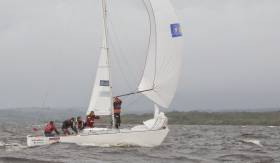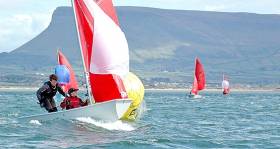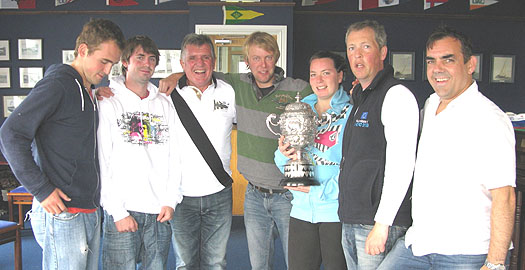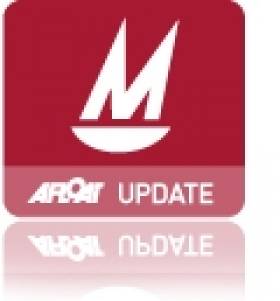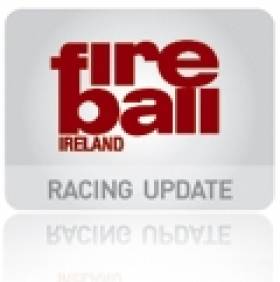Displaying items by tag: Sligo Yacht Club
A Howth Yacht Club J24 team won last weekend's Northern championships at Sligo YC with a race to spare. The K25 team beat JP McCaldin's Jamais Encore from Lough Erne Yacht Club for the top slot in a 19–boat fleet. Flor O'Driscoll's HArd on Port from the Royal St. George YC was third. Results are downloadable below.
Currently, the winning K25 team are in Poole in Dorset, a major J24 centre and are aiming to defend their ICRA title on home waters next month.
Sligo Yacht Club Stages Mirror Dinghy Western Championships
Lough Ree Yacht Club's Caoilin Croasdell & Alexander Farrel were the Overall and Gold Fleet Winners of the Mirror dinghy Western Championships at Sligo Yacht Club at the weekend.
Second place went to Oisin MacAllister & Rory MacAllister of Royal Cork Yacht Club. Silver Winners were Oscar Langan of Sutton Dinghy Club & Lughaidh Croasdell of Lough Ree Yacht Club.
Other placings
2016 Silver 2nd place Michael Broaders and Cian Lynch-Kealy of Sligo Yacht Club
2016 Silver 3rd place Sarah White and Eoghan Duffy of Sligo Yacht Club
2016 Bronze Winner Matthew White of Sligo Yacht Club and Niall MacAllister
2016 Bronze 2nd place Patrick Whyte and Jack Hayes of Mullingar Sailing Club GP14 & Mirror
2016 Bronze 3rd place Jack Curren and Ellen Curren of Sligo Yacht Club
Just Who Do The Irish Sailing Association Think They Are?
#irishsailing – Ireland's national sailing authority has been going through turbulent times in recent years. With unprecedented expansion of ISA staff numbers as the country revelled in the boom years of the Celtic Tiger, the arrival of the inevitable and abrupt financial downturn found an Association bloated, unfit to cope, and out of touch with ordinary sailors.
High profile events, top level training and international participation had become so dominant in the ISA's range of activities that many of the ordinary sailors of Ireland already felt the Association was no longer relevant to their own low key personal pursuit of friendly sport afloat.
When the crash came, it led to a marked decrease in active sailing numbers as disposable incomes fell away. People focused on keeping their jobs and businesses afloat rather than their boats sailing, while many promising young sailors were forced to emigrate.
This new reality was reflected by the growing disillusion of club officers, who saw their membership subscriptions decreasing even while the ISA – which is largely reliant on subvention from the clubs for its own income – seemed always to be looking for more money. And at the height of the boom years, when all the major clubs had put through significant expenditure in developing their facilities to international standards, the ISA had shown its lack of contact with the reality of club life by proposing its own stand-alone National Sailing Centre in Galway, a facility which would in effect have been run in rivalry to the main clubs. To the mutterings in the grass roots were added the rumblings from above as major clubs threatened to withhold their annual payment to the ISA unless real reform was initiated. W M Nixon takes up the story.
In a classic grass roots revolution, club sailors Norman Lee from Greystones in County Wicklow and Bryan Armstrong from Sligo were at first rebuffed when they tried to voice their concerns about the ISA's increasing irrelevance to the needs of the vast majority of sailing enthusiasts, people at local level who were doing their very best to keep the sport alive through torrid times.
The Irish sailing community now owes these two men and their supporters a debt of gratitude, for they believed in what they were saying and they refused to be turned aside. Eventually, in November 2013 moves were in place to establish a Review Group for the urgent analysis of all ISA activities, and its personnel drew comprehensively on Ireland's remarkable pool of people with hands-on experience of running successful sailing events and organisations.
It was chaired by Brian Craig of Dun Laoghaire who has headed up the organising team on more major and notably successful international sailing events in Dublin Bay than probably anyone else, and its able personnel included two former ISA Presidents - Roger Bannon of Dun Laoghaire and Neil Murphy of Malahide and Howth - who had both been noted for their skill in running a tight ship when they were in charge. With them was highly regarded International Race Officer Jack Roy of Dun Laoghaire, and renowned sailmaker/activist Des McWilliam of Crosshaven, who each year is inevitably seen in busy involvement afloat in more Irish sailing centres - large and small - than anyone else in the boat world.
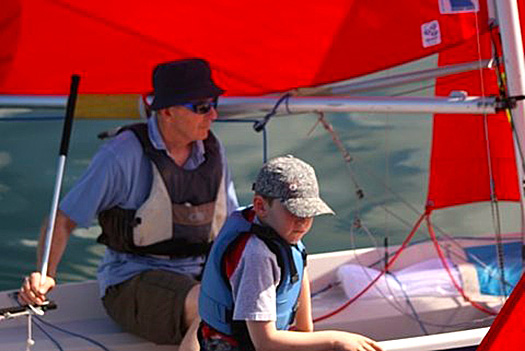
Bryan Amstrong of Sligo on the helm for a Mirror race
Also on board was one of the men from the barricades, Bryan Armstrong of Sligo. His background in a relatively remotely-located club which nevertheless has a long and distinguished sailing history made him uniquely qualified to voice the concerns of the grass roots. And we have to remember that all these people were giving voluntarily and generously of their time to this project in a period when Irish life was largely a matter of just getting through each day, while staying economically afloat was something of an achievement.
Primarily, the Review Group's function was to analyse the Association work on behalf of ordinary club sailors, as it was agreed that the Olympic and High Performance Divisions of the ISA's activities – which receive direct Sports Council grants – were in effect functioning as a different entity.
The Strategic Review Group was still work in progress when the ISA acquired a new President in David Lovegrove in March 2014, but by August the SRG published proposals which led to the setting up of a more formal body, the Planning Group. If this seems like a case of kicking the can down the road, it was anything but - these were people in a hurry, they'd got through the first stage of analysing areas where action was required, now they had to be more structured in coming up with clearcut ideas and concrete proposals.
This new Planning Group, which went into action in early Autumn 2014, was chaired by Neil Murphy, and its members included ISA President David Lovegrove, ISA Board Member Brian Craig, Ruth Ennis, Peter Redden, Sean Craig, and ISA CEO Harry Hermon, with noted Dun Laoghaire events administrator Ciara Dowling to provide administrative support.
They had their draft plan ready by mid-December 2014, and on January 21st 2015 Neil Murphy and his group publicly unveiled their analysis and proposals for the first time at a well-attended and very representative meeting in the Royal St George YC in Dun Laoghaire.
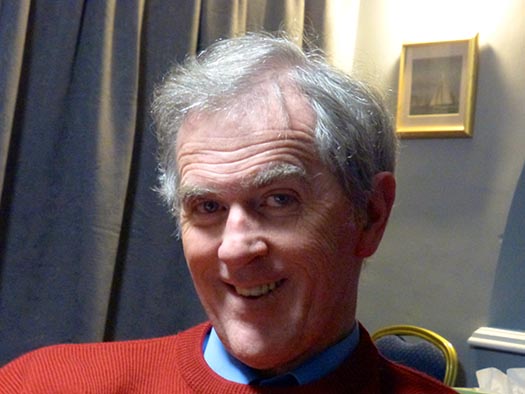 Neil Murphy is a former ISA President who, in addition to extensive experience as a Race Officer, is a typical club sailor, racing a Puppeteer 22 out of Howth. Photo: W M Nixon
Neil Murphy is a former ISA President who, in addition to extensive experience as a Race Officer, is a typical club sailor, racing a Puppeteer 22 out of Howth. Photo: W M Nixon
While those involved in setting the ISA on a healthier course are mostly working on a voluntary basis, it has to be said that the PowerPoint presentation and the printed material was of the highest professional class. In fact, it was much better than many professional shows I've been to, and the level of thought which went into a wide range of questions from the floor answered by Neil Murphy, Brian Craig and David Lovegrove generated a growing level of goodwill which concluded with Norman Lee voicing his congratulations and good wishes for this continuing process in which he and Bryan Armstrong had played such a key role.
So now we move on to the next stage – taking the ideas to the rest of the country. Doubtless you'll have noted the double meaning in titling this piece 'Just Who Do The ISA Think They Are?' In a first interpretation, that question is the one for which, let's hope, we are all now involved in working together in providing and implementing a satisfactory answer.
But equally, as the ISA Road Show gets out of Dublin to take this excellent presentation to a public meeting in Cork next week (it's in the Rochestown Park Hotel on Tuesday, Feb 17th, 7.0 pm to 9.0 pm) and then Galway the week after (Galway Bay Sailing Club, Tuesday 24th February 7.0 pm to 9.0pm), they'll be taking themselves into areas where experience of sailing administration long pre-dates the establishment of organised sailing on Dublin Bay.
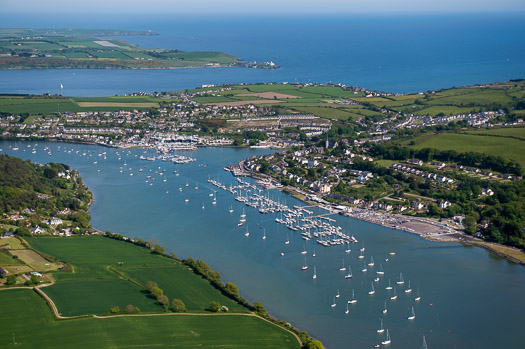 Crosshaven in the summer time. When we look at the natural advantages to be found here, it's little wonder that structured recreational sailing on Cork Harbour long-pre-dated any organised sport on Dublin Bay. Photo: Robert Bateman
Crosshaven in the summer time. When we look at the natural advantages to be found here, it's little wonder that structured recreational sailing on Cork Harbour long-pre-dated any organised sport on Dublin Bay. Photo: Robert Bateman
So you might well ask just just who do they think they are, these people from Dublin, going down to Cork to try to tell them how sailing should be organised? The nerve of them, doing it in a place where they've had organised sailing since 1720, and where the two biggest clubs – the Royal Cork and Kinsale – are both mighty establishments of international sailing repute which would remain so even were the ISA to disappear overnight in a puff of smoke...
And as for going west along the road to Galway, that will take them through Athlone where the Lough Ree Yacht Club dates back to 1770, while on the west coast the Royal Western of Ireland YC at Kilrush traces its origins back to 1828. Equally, further north along the Atlantic coast Sligo YC dates back to 1821, and in Lough Erne the club began in 1820. Yet the first club on Dublin Bay, the Royal Irish, only began as recently as 1831, and even then it barely hung in and had to be revived in 1846, with the pace being set in the meantime by the Royal St George YC, founded 1838.

Kinsale is another harbour which seems to have been designed with sailing primarily in mind. Photo: Kevin Dwyer/courtesy ICC

Kilrush on the Shannon Estuary had a club in being before there were any sailing institutions on Dublin Bay. Photo: W M Nixon
So in terms of sailing administration history, Dublin and Dun Laoghaire are only Johnny-come-lately places by comparison with just about everywhere else in Ireland. Yet thanks to the inevitable dominance of economic development, population growth and the strengthening centres of political power, we now find that sailing administration and decisions of national import are emanating from a place that, in terms of natural sailing advantages, lags far behind the rest of the country.
Oh for sure, Dun Laoghaire Harbour is a fabulous artificial amenity, and the advent of the new marina at Greystones has already been seized upon as greatly increasing the "cruising" options of Dublin Bay. But let's face it, Dublin Bay is really only good for racing, specific day sailing and training, whereas Cork Harbour and Kinsale provide such a variety of opportunities for interesting race courses, mini-cruises with multiple destinations and what have you, that in effect they're not just in a different part of the country – they're a different country altogether.

Dun Laoghaire is a totally artificial facility, and sailing options on Dublin Bay are limited. But it's inescapable that this is the primary point of leisure access to the sea for Ireland's largest and most affluent population. Photo: Kevin Dwyer/courtesy ICC
All of which adds to the difficulties of creating a meaningful national authority with which every sailing person can identify.
This business of Dublin v The Rest is not unique to sailing, of course, but when you have a specialist sport with multiple sub-branches of activity, the problem is exacerbated.
So please bear this in mind if you take yourself along to the meetings in Cork or Galway during the next ten days. This really is a genuine attempt to base the ISA within the sailing community at an everyday level of usefulness to all, with scope for growth while enhancing existing structures, and input from the sailing community at this stage will help in developing the ideas and initiatives proposed.
While the draft ISA Strategic Plan 2015-2020 very definitely puts the emphasis back on to the need for healthy well-run clubs as the basis for the sport, there was initially a feeling at the meeting on January 21st that the new-look ISA is not supportive of commercial sailing schools. In fact, what the new-look ISA hopes to do is encourage training schemes within clubs, while at the same time supporting commercial sailing schools where the demand is such that no club could realistically cope while maintaining its essential club ethos.
Going into this in more detail in a personal meeting this week with Neil Murphy, who is a Chartered Quantity Surveyor, we talked around the fact that a thriving club scene is central to the spirit of Irish sailing, and he was musing on the success of Sutton Dinghy Club where Hugh Gill heads up what is in effect a commercial sailing school within a club setting.
In fact, what Murphy would hope to see emerge at larger population centres is sailing's equivalent of the public golf course. Anyone who has used a public golf course will be aware that the proprietors are usually mustard keen to encourage the formation of a "club" within their customer base, and there is no reason why this shouldn't eventually take root in Irish sailing, providing access to sailing at a fraction of the cost of joining an established club.
It's not something which can realistically be objected to by established clubs trying to protect their own membership, as the people who would use a "public sailing club" would be those who simply couldn't afford to go sailing at all in the current traditional club setup.
Nevertheless support for the established club setup is central to the new Strategic Plan, and the provision of Regional Development Officers to serve clubs directly is very much to the fore in the new thinking. But in looking over the figures published with the report, it's good to note that the ISA works with no less than 80 recognised training centres, while an encouraging statistic is that there are now 24 secondary schools in Ireland which include sailing as a regular part of their curriculum. Admittedly it's a long way from the French setup where every schoolkid is entitled by law to one week of sailing and one week of skiing per year, but in a country where an aversion to being on the water used to be thought inevitable, it's a step in the right direction.
All these considerations of inexpensive sailing are a whole world away from the stories of recent weeks and days about the ISA's High Performance Division seeking a fund-raising executive who will be tasked with finding €2.75 million per annum through philanthropic and other donations in order to help the funding of top level campaigns which we're not allowed to call Olympic campaigns, as apparently that is copyrighted by the Olympic Council, so we call them High Performance instead.
But apparently Government departments aren't restricted by this limitation on the use of the word Olympic, for it was bandied about like nobody's business in this week's news that the government is spending mightily through the Sports Council, with sailing being number three in all Ireland in terms of current Sports Council funding, with a total tag of €1,289,900.
Of course it's not all for specifically Olympic sailing, but it covers 103 sailors from Optimists to the Olympics. Which is fine and dandy for those who are mad keen to race at the highest level, but most sailors in Ireland are much more interested in performing well within their chosen area and boat class, but with sailing being just part of a reasonably civilised and well-balanced life.
And as became evident at the meeting on January 21st, there's an increasing number of people who feel that sailing needs to realise that there's a sizeable population out there of folk who'd like to go sailing, but don't feel the almost religious vocation to own a boat.
With the rapid expansion of sunshine sailing holidays with boats and equipment readily available for hire at the destination, there's a strong feeling there's a real need for more of this in Ireland, even if we can't guarantee the sunshine. The suggestion brings us back to both the "public sailing club" concept, and the growing realisation by established clubs that they have to reach out to potential members by having boats available for sailing on a trial basis.

The Affordable Sailing Team – Norman Lee (right) with his brother Ken beside their campervan at last year's GP 14 Worlds at East Down YC on Strangford Lough. Photo: W M Nixon
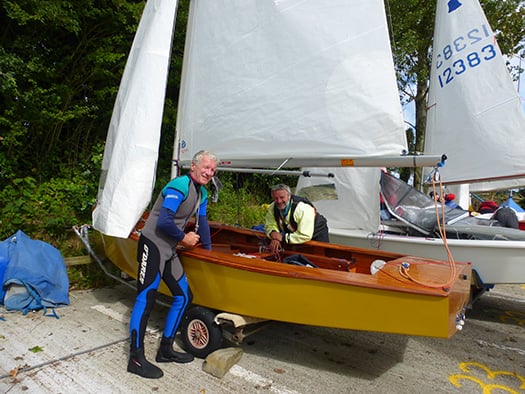
With their own very high can-do standards of boat maintenance, Norman and Ken Lee can keep their GP 14 in the competitive frame. Photo: W M Nixon
That said, the need to own one's own boat and tune and tinker with her to your heart's content is what sailing is all about for many of us, and Norman Lee is a classic case in point for this approach. He claims that his sailing costs him just €600 per year, though that of course is after he has paid for his well-tuned GP14, and he has long since written off the cost of the vintage camper-van which is home to the Lee Equipe when they hit the campaign trail.
Nevertheless the entire setup has to be outstandingly good value, and doing it in such economical style is part of the fun of it all. So when someone with Norman Lee's approach to sailing is prepared to get up at the big ISA public meeting in Dun Laoghaire and congratulate the team who have been working on the reforms which he and Bryan Armstrong set in train, then that is approval of a high order.
And as for just who or what is the ISA, can we maybe agree that ideally we all are the ISA, every last one of us who goes sailing or is even just interested in the sport, and it's up to us to keep it in line and encourage it to identify with and serve the ordinary sailor every bit as much as the high-flyer.

Private pleasure.....the 2014 GP 14 Worlds at East Down YC is about as high as many Irish sailors would expect or want to aim, and many are content with much lower-key regular club sailing. Photo: W M Nixon
Sutton Dinghy Club Pair Win Mirror National Championships
#mirror – The 2014 Mirror National Championships were held at a resplendent Sligo Yacht Club from August 7th to 10th. Twenty three Mirror Class Dinghies gathered for what proved to be an action packed four days of sailing on the enchanting waters of Sligo Bay.
The fleet faced very tricky sailing conditions over the four days in relatively light and shifty winds, not the norm for Sligo Bay. Conditions notwithstanding, the event was a major success with not a single general recall throughout the four days. A big thank you to all the competitors and families that made the trip to Sligo.
Shane Mcloughlin and his crew Oscar Langan from Sutton Dinghy Club mastered the conditions best, demonstrating some excellent sailing skills to take overall honours. Fast improving locals, Samuel and Imogen Wray took the honours in the silver fleet while Muiris Fitzgerald and Ellen O' Dwyer, also local, topped the bronze fleet.
Ten races were held over the four days. Forty six eager sailors set out on Thursday to do battle in hellishly tricky winds. One could not but have sympathy for OD Brendan Brogan as winds varied over 90 degrees, playing havoc with course laying. In the end, patience proved a virtue and Lough Ree's Tiernan Dickson took the first race with Shane Mc Loughlin and Jack Maye filling second and third spots. Lough Ree Yacht Club was again to the fore in the second race as the rapidly improving pair, Caolan Crossdell and Schull Harbour's very own Oisin MacAllister took line honours in a tight finish from Tiarnan Dickson and Alex Leech, in what was surely the performance of the weekend.
Day two was again frustrating for sailors as the shifting winds caused quite a few delays. Some sailors learned the hard way about the strong tides in Sligo Bay, while racing in the calm conditions. Shane McLoughlin from Sutton Dinghy Club turned the heat up, winning two races and finishing second in the last race to claim the overnight lead. Sligo's Beth Armstrong took the honours in the last race shooting right into contention behind Shane Mc Loughlin and the ever consistent Tiarnan Dickson. The two Jack's, Maye and Ryan kept their hopes up with a second place each.
Day three brought more shifty wind conditions to challenge the fleet. It was Tiarnan Dickson's turn to pile on the pressure with two wins and a third place finish. Ominously though, Shane Mcloughlin had two seconds and a win. The gap between the pair was just two points entering the final day. Beth Armstrong put in a very consistent shift and went into the last day right in contention should there be any slip ups.
Day four saw somewhat more consistent winds during which the final two races were sailed. Shane Mc Loughlin took the first from Beth Armstrong with Jack Maye in third. The final race turned into a local duel between cousins Beth Armstrong and Jack Maye, Jack taking an extended lead before Beth came through to take line honours and bring the shutters down on a thoroughly enjoyable 2014 National Championship.
And so it was, a splendid four days for the Mirror fleet soaked in the famous hospitality of Sligo Yacht Club. Those lucky enough to be present were reminded of the glory days of Irish sailing. Mingling with sailors, parents and club members, it was easy to understand how the Mirror Class has contributed so much to so many in Irish sailing down through the years.
Results:
Gold Fleet:-
1] Shane Mc Loughlin / Oscar Langan 12 points Sutton Dinghy Club [SDC]
2] Tiarnan Dickson / Alex Leech 18 points [LRYC]
3] Beth Armstrong / Dylan Shaw 20 points [SYC]
Silver Fleet:-
1] Samuel Wray / Imogen Wray [SYC]
2] Helen Smith / Noah Canham [SYC]
3] Rory Mc Allister / Lughaidh Croasdell [Schull Harbour & LRYC]
Bronze:-
I] Muiris Fitzgerald / Ellen O' Dwyer [SYC]
2] Sarah White / Matthew White [SYC]
3] Hannah Raftery / Ben Kelly [SYC]
#gp14 – With the upcoming GP14 World Championships in August, this year's Irish Nationals was shortened to a two day event and held under the burgee of Sligo Yacht Club. A fleet of 41 boats (including 12 boats from the host club) set up camp at Rosses point, just north of Sligo to compete for the 2014 GP14 Championship of Ireland. Despite light & variable conditions, the weekend didn't disappoint and with some masterful sailing, Olympian Ger Owens sailing with Melanie Morris retained the GP14 Championship title they won in Sutton last year.
OD, Gus Henry, took his fleet of rescue and mark boats out on the water early on Saturday despite a forecast of low winds. The fleet were initially held ashore but after a short 30 minute postponement due to the fickle wind, were told to take to the water. Stephen Boyle was unable to make this event but it was great to see crew Eanna Lawless take over the helm of his boat and with Sinead Dickson crewing they had the bragging rights of being first boat to the first weather mark in race 1. However as the wind continued to veer and the first reach turned into run the race officer made the decision to call the fleet back and restart the race.
This time it was Shane MacCarthy & Damian Bracken who led at the first mark followed by Curly Morris & Laura McFarland. On the second upwind however, places changed with Ger & Melanie taking the lead which they held for the rest of the race. Second were Tim Corcoran & Brendan Brogan who up to now had been taking a year's sabbatical but showed that this hadn't affected any of their boatspeed. Third place went to recent Ulster champions Alan Blay & David Johnston.
Race 2: With the fleet starting under the black flag, there were a number of recalls and subsequent casualties. It seems a combination of over enthusiasm and strong tidal current caught out many crews. After 2 general recalls there were 10 who were deemed to be over and had to sit out and watch the race which eventually got away at the 3rd attempt. Local sailors Damian Mullen & Sam Wray seemed to benefit from the ebbing tide on the left hand side of the beat and came in to the first mark with a big lead. Ultimately they were overhauled by both Ger & Melanie and Sligo pairing Paddy O'Connor & Colm O' Flaherty.
Race 3: Race 3 saw the breeze again move to the west but gain in strength and become more constant. The OD decided to move the course more out to sea. Another black flag start and two more victims included the pairing of Paddy & Colm who were leading at the windward mark before being hauled out of the race. This left Tim & Brendan to take over the lead and they sailed a great race to take the win from Niall Henry & Ossian Geraghty.
So after day 1 with three races completed the overnight leaders were Ger & Melanie followed by Alan Blay & David Johnston and John & Donal McGuinness in third. The silver fleet was led by Cathal Sheridan, with Ronan Armstrong leading the bronze fleet.
On Sunday morning the fleet launched to what initially looked like more breeze but which subsequently started to ease off again. Race 4 saw the fleet split upwind, hitting both the left and right corners of the beat. Ultimately boats that went right benefitted hugely from more pressure and a right hand shift. Local sailors Niall & Ossian led at the first mark and were never challenged. They were followed home by Coleman Grimes & David Lapin and Shane MacCarthy & Damian Bracken.
Race 5 was a close fought race between the lead boats of Ger & Melanie, Tim & Brendan, and Alan & David, and this is the order they finished in. The race win cemented the stranglehold that Ger & Melanie had on the event, as they showed great skill and speed in the prevalent light winds of the weekend.
Race 6 a further wind shift led to yet another resetting of the course for the final race of the event. At which point some crews decided they had had enough of the pernickety winds off Rosses Point and headed ashore. Of the remaining fleet, first around the weather mark was Norman & Ken Lee, who had a good lead over the event leaders Ger & Melanie. Norman was even able to extend his lead over the first two laps. On the upwind leg of the sausage, there was another wind shift which Ger & Melanie made the better use of to emerge around the weather mark in first place, which was maintained to the end of the race. Norman & Ken finished the race in second place with Shane & Damian crossing the line in third. The wind then died completely leaving about half the fleet stranded on the run. The SIs allowed for all to be given their position at the weather mark as their finishing position rather than a DNF. The majority of the fleet having been towed ashore due to the wind dropping anxiously awaited the results of the event although there were to be no surprises as to the overall winner!
After the numbers were crunched the 2014 GP14 Champions of Ireland were Ger Owens & Melanie Morris with a points total of 7. In second place was local sailor and rear-commodore Niall Henry & Ossian Geraghty who beat Shane McCarthy & Damian Bracken by virtue of their win in race 4.
Winner of the silver fleet was Katie Dwyer & Michelle Rowley of Sutton Dinghy Club sailing in their first event together and finishing a very impressive 10th overall. Winner of the bronze fleet was Simon Jeffery crewed by Rebecca Jeffery of East Down Yacht Club.
Winner of the Championship Junior Helm (u19) was Dan Gill from Sutton Sailing club.
At the prize giving Ger Owens said a few words on behalf of the sailors highlighting that all three GP14 events this year have been won by different crews and that with excellent turnouts, the fleet is in good health and should be confident of doing well in a couple of weeks at the World Championships in East Down YC
GP14 Overall Results:
1. Ger Owens & Melanie Morris (7 points)
2. Niall Henry & Ossian Geraghty (25 points)
3. Shane MacCarthy & Damian Bracken (25 points)
4. Alan Blay & David Johnston (30 points)
5. Dan & Mairin O'Connell (36 points)
6. Tim Corcoran & Brendan Brogan (38 points)
7. John McGuinness & Donal McGuinness (38 points)
8. Paddy O'Connor & Colm O'Flaherty (39 points)
9. Alastair Duffin & Brendan McGrenaghan (44 points)
10. Katie Dwyer & Michelle Rowley (48 points)
#yachtclubs – The antiquity of Irish recreational sailing is beyond dispute, even if arguments arise as to when it started, and whether or not the Royal Cork YC really is the world's oldest club in its descent from the Water Club of the Harbour of Cork from 1720. But all this seems academic when compared with the impression made by relics of Ireland's ancient sailing traditions.
In just six short years, the Royal Cork Yacht Club will be celebrating its Tercentenary. In Ireland, we could use a lot of worthwhile anniversaries these days, and this 300th has to be one of the best. The club is so firmly and happily embedded in its community, its area, its harbour, in Munster, in Ireland and in the world beyond, that it is simply impossible to imagine sailing life without it.
While the Royal Cork is the oldest, it's quite possible it wasn't the first. That was probably something as prosaic as a sort of berth holder's association among the owners of the ornamental pleasure yachts which flourished during the great days of the Dutch civilisation in the 16th and 17th Centuries. They were based in their own purpose-built little harbours along the myriad waterways in or near the flourishing cities of The Netherlands. Any civilisation which could generate delightful bourgeois vanities like Rembrandt's Night Watch, or extravagant lunacies such as the tulip mania, would have had naval-inspired organised sailing for pleasure and simple showing-off as central elements of its waterborne life.
Just sailing for pleasure and relaxation, rather than going unwillingly and arduously afloat in your line of work, seems to have been enough for most. Thus racing – which is the surest way to get some sort of record kept of pioneering activities – was slow to develop, even if inter-yacht matches were held, particularly once the sport had spread to England with the restoration of Charles II in 1660.
Ireland had not the wealth and style of either Holland or England, but it had lots of water, and it was in the very watery Fermanagh region that our first hints of leisure sailing appeared. It's said of Fermanagh that for six months of the year, the lakes are in Fermanagh, and for the other six, Fermanagh is in the lakes. Whatever, the best way to get around the Erne's complex waterways system, which dominates Fermanagh and neighbouring counties, was by boat. By the 16th Century Hugh Maguire, the chief of the Maguires, aka The Maguire, had a Lough Erne-based fleet, some boats of which were definitely for ceremonial and recreational use.
Sport plays such a central - indeed total - role in Irish life that it's highly likely these pleasure sailing boats were sometimes used for racing. However, the first recorded race anywhere in Ireland took place in Dublin Bay in 1663 when the polymath Sir William Petty, having built his pioneering catamaran Simon & Jude, then organised a race with a Dutch sailing vessel and a local "pleasure boatte" of noted high performance. This event, re-sailed in 1981 when the indefatigable Hal Sisk organised the building of a re-creation of the Simon & Jude, resulted both times in victory for the new catamaran. But because a larger sea-going version of the Simon & Jude, called The Experiment at the suggestion of Charles II himself, was later to founder with all hands while on a testing voyage in the Bay of Biscay, the multi-hull notion was abandoned in Europe for at least another two centuries.
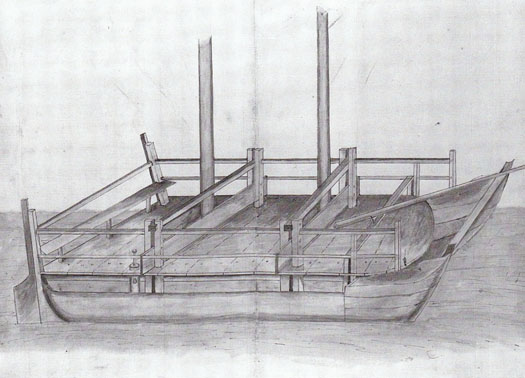
Contemporary drawing of the 17th Century catamaran Simon & Jude, which was built in Dublin and tested in the bay in an early "yacht race" in 1663.
We meanwhile are left wondering just what was this "pleasure boatte" was, and who owned and sailed it. Its existence and good sailing performance seems to have been accepted as unremarkable in Dublin Bay, yet no other record or mention of it has survived.
It was the turbulent life of Munster in the 17th Century which eventually created the conditions in which the first yacht club was finally formed. As the English Civil War spread to Ireland at mid-Century with a mixture of internecine struggle and conquest, the Irish campaigner Murrough O'Brien, the Sixth Baron Inchiquin, changed sides more than once, but made life disagreeable and dangerous for his opponents whatever happened to be the O'Brien side for the day.
Yet when the forces supporting Charles II got back on top in 1660 after the death of Cromwell in 1658, O'Brien was on the winning side. As the dust settled and the blood was washed away, he emerged as the newly-elevated Earl of Inchiquin, his seat at Rostellan Castle on the eastern end of Cork's magnificent natural harbour, and his interests including a taste for yachting acquired with his new VBF Charles II.
But there was much turmoil yet to come with the Williamite wars in Ireland at the end of the 17th Century. Yet somehow as the tide of conflict receded, there seemed to be more pleasure boats about Cork Harbour than anywhere else, and gradually their activities acquired a level of co-ordination. The first Earl of Inchiquin had understandably kept a fairly low profile once he got himself installed in his castle, but his descendants started getting out a bit and savouring the sea. So when the Water Club came into being in 1720, the fourth Earl of Inchiquin was the first Admiral.
In the spirit of the times, having an aristocrat as top man was sound thinking, but this was truly a club with most members described as "commoners", even if there was nothing common about their exceptional wealth and their vast land-holdings in the Cork Harbour area. Much of it was still most easily reached by boat, thus sailing passenger vessels and the new fancy yachts interacted dynamically to improve the performance of both.
Yet there was no racing. Rather, there was highly-organised Admiral Sailing in formation, something which required an advanced level of skill. However, many of the famous club rules still have a resonance today which gives the Water Club a sort of timeless modernity, and bears out the assertion by some historians that, as it all sprang to life so fully formed, the formation date of 1720 must be notional, as all the signs are that there had been a club of some sort for years beforehand.
But either way, it makes no difference to the validity or otherwise of the rival claim, that the Squadron of the Neva at St Petersburg in Russia, instituted by the Czar Peter the Great in 1718 to inculcate an enthusiasm for recreational sailing among Imperial Russia's young aristocrats, was the world's first yacht club. It was no such thing. It was in reality a unit of the Russian navy, and imposed by diktat from the all-powerful ruler. As such, it was entirely lacking the basic elements of a true club, which is a mutual organisation formed by and among equals.
Yet as the Water Club of the Harbour of Cork had no racing with results published in what then passed for the national media, we are reliant on the few existing club records and some travel writing from the time for much of our knowledge of the early days of the Water Club. That, and the Peter Monamy paintings of the Water Club fleet at sea in 1738.
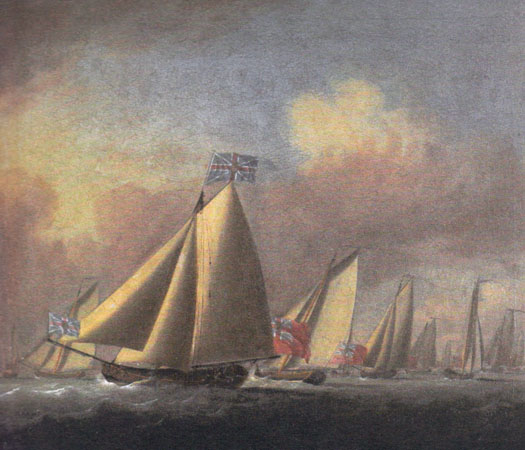
A remarkably well-disciplined fleet. Peter Monamy's 1738 painting of the yachts of the Water Club at sea off Cork Harbour. They weren't racing, but were keeping station in carefully-controlled "Admiral Sailing". Courtesy RCYC
Fortunate indeed are the sailors of Cork, that their predecessors' activities should have been so superbly recorded in these masterpieces of maritime art. The boats may look old-fashioned to a casual observer, yet there's something modern or perhaps timeless in this depiction of the fleet sailing in skilled close formation, and pointing remarkably high for gaff rigged boats as they turn to windward. Only a genuine shared enthusiasm for sailing could have resulted in such fleet precision, and in its turn in a memorable work of art. It is so much part of Irish sailing heritage that we might take it for granted, but it merits detailed study and admiration no matter how many times you've seen it already.
Shortly after Monamy's two paintings were completed, Ireland entered a period of freakish weather between 1739 and 1741 when the sun never shone, yet it seldom if ever rained, and it was exceptionally cold both winter and summer. It is estimated that, proportionately speaking, more people died in this little known famine than in the Great Famine itself 104 years later. While the members of the Water Club would have been personally insulated from the worst of it, the economic recession which struck an intensely agricultural area like Cork affected all levels of society.
Thus the old Water Club saw a reduction in activity, but though it revived by the late 1740s, the sheer energy and personal commitment of its early days was difficult to recapture, and by the 1760s it was becoming a shadow of its former self. Nevertheless there was a revival in 1765 and another artist, Nathanael Grogan, produced a noted painting of Tivoli across from Blackrock in the upper harbour, with a yacht of the Water Club getting under way for a day's recreation afloat, the imminent departure being signalled by the firing of a gun.
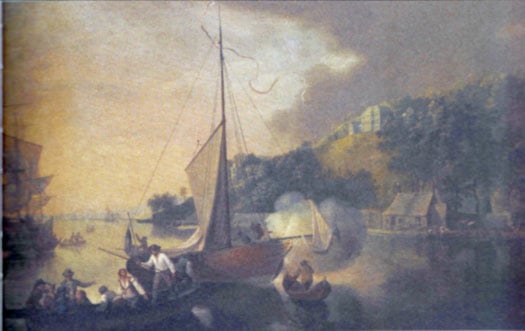
The best way to get the crew on board....on upper Cork Harbour at Tivoli in 1765, a yacht of the reviving Water Club fires a gun to signal imminent departure.
However, it was on Ireland's inland waterways that the next club appeared – Lough Ree Yacht Club came into being in 1770, and is still going strong. That same year, one of the earliest yacht clubs in England appeared at Starcross in Devon, but it was in London that the development pace was being most actively set with racing in the Thames for the Cumberland Fleet. Some members of this group, after the usual arguments and splits which plague any innovative organisation, in due course re-formed themselves as the Royal Thames Yacht Club in the early 1800s. But the famous yet unattributed painting of the Cumberland Fleet racing on the Thames in 1782, while it is slightly reminiscent of Monamy's painting of the Water Club 44 years earlier, undoubtedly shows boats racing. And they'd rules too – note the port tack boat on the right of the picture bearing off to give way to the boat on starboard.
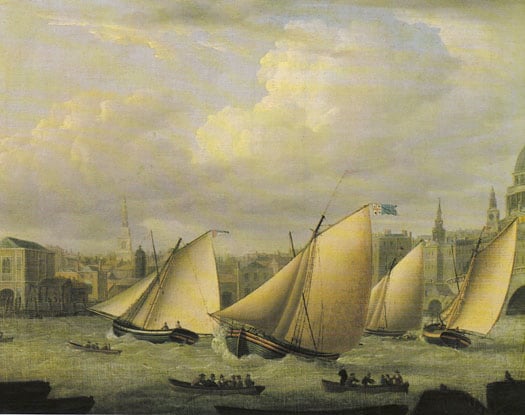
Definitely racing – the Cumberland Fleet, precursor of the Royal Thames Yacht Club, racing in the River Thames at Blackfriars in 1782.
The Thames was wider in those days, but even so they needed strict rules to make racing possible. Dublin Bay offered more immediate access to open water, and there were certainly sailing pleasure boats about. When the Viceroy officially opened the Grand Canal Dock on April 23rd 1796, it was reported that the Viceregal yacht Dorset was accompanied by a fleet of about twenty ceremonial barges and yachts. Tantalisingly, the official painting is almost entirely focused on the Dorset and her tender, while the craft in the background seem to be naval vessels or revenue cutters.
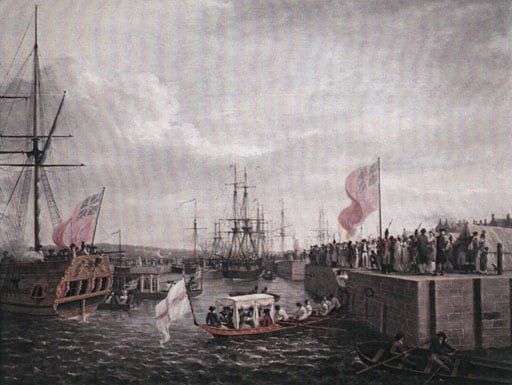
This painting of the opening of the Grand Canal Dock in 1796 tends to concentrate on the ceremonials around the Viceroy's yacht Dorset in the foreground, but fails to show clearly any of the several privately-owned yachts which were reportedly also present....
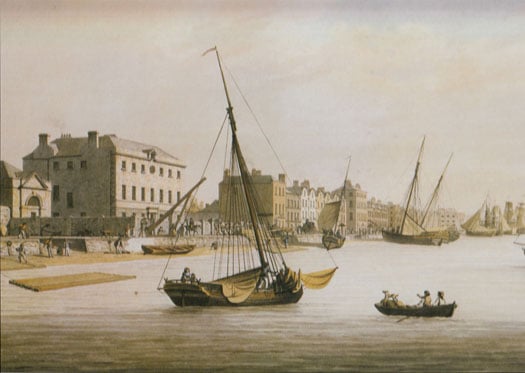
.......but this illustration of the old Marine School on the South Quays in Dublin in 1803 seems to have a yacht – complete with owner and his pet dog on the dinghy in the foreground – anchored at mid-river.
However, a Malton print of the Liffey in 1803 shows clearly what is surely a yacht, the light-hearted atmosphere of waterborne recreation being emphasised by the alert little terrier on the stern of the tender conveying its owner in the foreground Meanwhile in the north of Ireland there was plenty of sailing space in Belfast Lough, while Belfast was a centre of all sorts of innovation and advanced thinking. Henry Joy McCracken, executed for his role in the United Irishmen's rising in 1798, was a keen pioneer yachtsman. As things took a new turn of determined money-making in Belfast after the Act of Union of 1801, some of his former crewmates were among those who formed the Northern Yacht Club in 1824, though it later transferred its activities across the North Channel to the Firth of Clyde, and still exists as the Royal Northern & Clyde YC.
Meanwhile in 1806 the old Water Club of the Harbour of Cork had shown new signs of life, but one result of this was an eventual agreement among members - some of them very old indeed, some representing new blood - that the club would have to be re-structured and possibly even given a new name in order to reflect fresh developments in the sport of yachting. The changeover was a slow business, as it had to honour the club's history while giving the organisation contemporary relevance. Thus it was 1828 before the Royal Cork Yacht Club had emerged in this fully fledged new form, universally acknowledged as the continuation of the Water Club, and incorporating much of its style.
But it was across the north on Lough Erne in 1820 that the world's first yacht club specifically set up to organise racing was formed, and Lough Erne YC continues to prosper today, its alumnae since 1820 including early Olympic sailing medallists and other international champions.
There must have been something in the air in this northwest corner of Ireland in the 1820s, for in 1822 the men who sailed and raced boats on Lough Gill at Sligo had a pleasant surprise. Their womenfolk got together and raised a subscription for a handsome silver trophy to be known as the Ladies' Cup, to be raced for annually – and it still is.
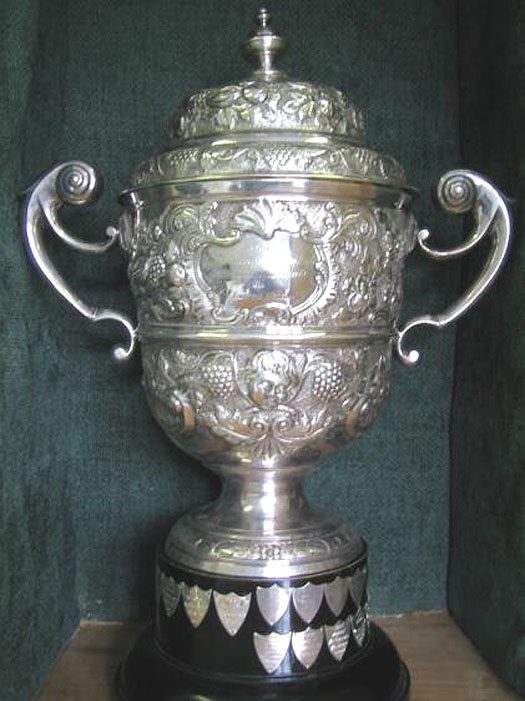
Instituted in 1822, the Ladies' Cup of Sligo YC is the world's oldest continually-contested annual sailing trophy.
Annual challenge cups now seem such a natural and central part of the sailing programme everywhere that it seems extraordinary that a group of enthusiastic wives, sisters, mothers and girlfriend in northwest Ireland were the first to think of it, yet such is the case. Or at least theirs is the one that has survived for 192 years, so its Bicentenary in 2022 is going to be something very special.
Those racing pioneers of the Cumberland Fleet had made do with new trophies freshly presented each year. And apparently the same was the case initially at Lough Erne. But not so very far down the road, at Sligo, somebody had this bright idea which today means that the museum in Sligo houses the world's oldest continually raced-for sailing trophy, and once a year it is taken down the road to the Sligo YC clubhouse at Rosses Point to be awarded to the latest winner – in 2013, it was the ever-enthusiastic Martin Reilly with his Half Tonner Harmony.
The Ladies Cup was won in 2013 by Martin Reilly's Half Tonner Harmony. Pictured with their extremely historic trophy are (left to right) Callum McLoughlin, Mark Armstrong, Martin Reilly, John Chambers, Elaine Farrell, Brian Raftery and Gilbert Henry
However, although the Ladies' Cup may have pioneered a worthwhile trend in yacht racing, it wasn't until 1831 that they thought of inscribing the name of the winner, and that honour goes to Owen Wynne of Hazelwood on the shores of Lough Gill. But by that time the notion of inscribing the winners was general for all trophies, and a noted piece of the collection in the Royal Cork is the Cork Harbour Regatta Cup 1829, and on it is inscribed the once-only winner, Caulfield Beamish's cutter Little Paddy.
The name of noted owner, skipper and amateur yacht designer Caulfield Beamish came up here some time back, when we were discussing how in 1831 he took a larger new yacht to his own design, the Paddy from Cork, to Belfast Lough where he won a stormy regatta. So you begin to understand the mysterious enthusiasm people have for sacred relics when you see this cup with its inscription, and realise that it's beyond all doubt that this now-forgotten yet brilliant pioneer of Cork Harbour sailing development personally held this piece of silverware.
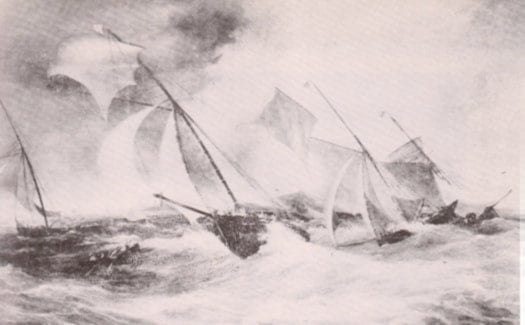
Caulfield Beamish's new cutter Paddy from Cork (which he designed himself) winning a stormy regatta in Belfast Lough in 1831
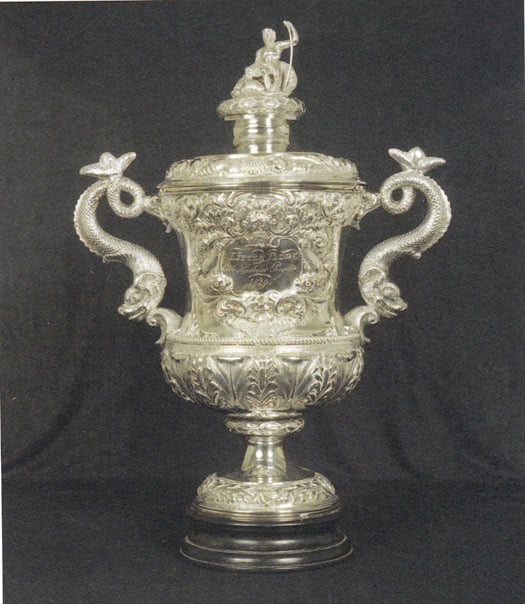
The Cork Harbour Regatta Cup of 1829.....Courtesy RCYC
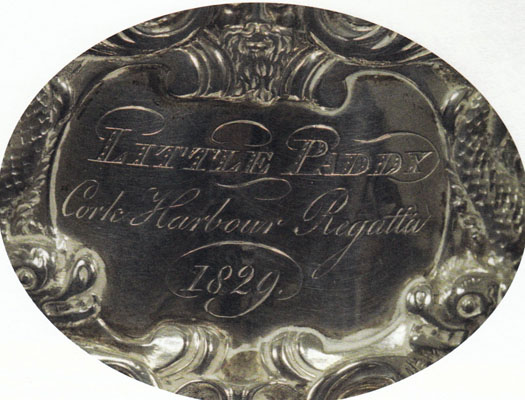
....and on it is inscribed the winner, Caulfield Beamish's earlier boat, Little Paddy, which he also designed himself. Courtesy RCYC
Another pioneer in yacht racing at the time was the Knight of Glin from the Shannon Estuary, who in 1834 was winning all about him with his cutter Rienvelle, his season's haul including a silver plate from a regatta in Galway Bay – it's now in Glin Castle – while he also seems to have relieved fellow Limerick owner William Piercy of £50 for a match race in Cork Harbour against the latter's cutter Paul Pry.
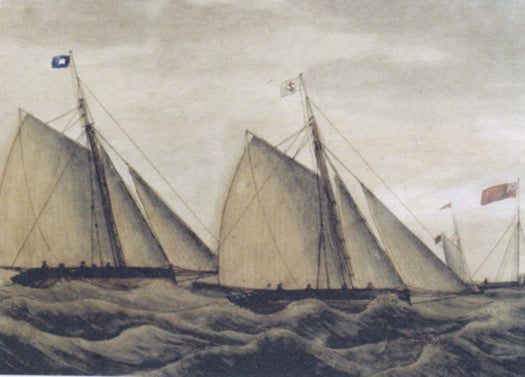
The lads from Limerick hit Cork. William Piercy's Paul Pry racing for a wager of £50 against the Knight of Glin's Rienvelle in Cork Harbour in 1834. When Paul Pry won Cork Harbour Regatta a few weeks later, the band on the Cobh waterfront played Garryowen. Courtesy RCYC
But of all the fabulous trophies in the Royal Cork collection, the one which surely engenders the most affection is the Kinsale Kettle. It goes back "only" to 1859, when it was originally the trophy put up for Kinsale Harbour Regatta. But this extraordinarily ornate piece of silverware was not only the trophy for an annual race, it was also the record of each race, as it's inscribed with brief accounts of the outcomes of those distant contests.
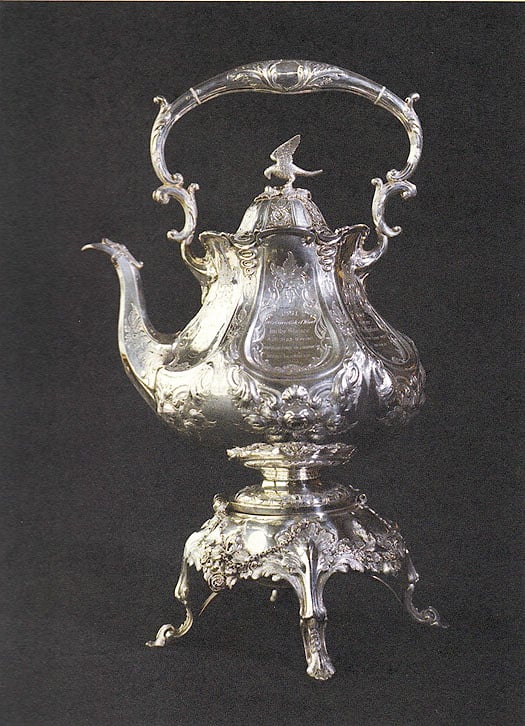
An extraordinary piece of Victorian silverware. The "Kinsale Kettle" from 1859 is now the Royal Cork YC's premier trophy.
Today, it continues to thrive as the Royal Cork Cup, the premier award for Cork Week. The most recent winner in 2012 was Piet Vroon with his superb and always enthusiastic Tonnere de Breskens. The fact that this splendid ambassador for Dutch sailing should be playing such a central role in current events afloat here in Ireland brings the story of our sport's artworks and historical artefacts to a very satisfactory and complete circle.
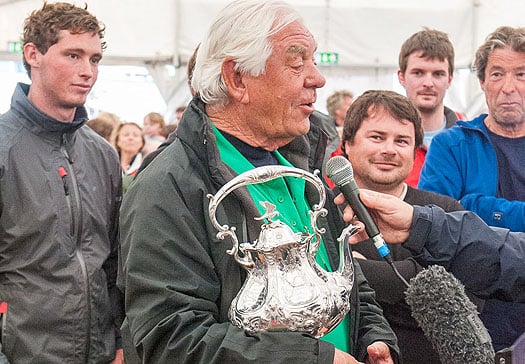
More tea, skipper? The current holder of the Kinsale Kettle, aka the Royal Cork Cup, is Piet Vroon of Tonnere de Breskens. Photo: Bob Bateman
Local Crew Win Mirror Nationals at Sligo Yacht Club
#mirror – Overall honours at the Mirror dinghy national championships in Sligo went to local sailors Jack Maye and Sarah White at the weekend.
After two days of training kindy provided by Sligo Yacht Club the Mirror fleet, from Bronze to Gold, were well prepared for 4 days of extremely variable conditions and tight racing results. Thursday saw light winds which gave the lighter helm and crew a chance to perform well. Friday was a day of doldrums and scorching sunshine which led to a day of patient floating about and ended up with some essential swimming and diving to cool off. Despite the best efforts of vetran Race Officer Gus Henry however, no race could be started. On Saturday the winds picked up with force 7 gusts and numerous capsizing of all ages and skills levels came to the fore, so the OD announced that all Bronze fleet must go in after the first race. The course was then moved inshore where there was some shelter and the gold and silver fleets had two very exciting races. The overnight leaders were Harry & Fergus Collins of Sligo, a considerable achievment for them as they were Silver Fleet sailors.
It was all down to the Sunday, the last day. By then gold and Silver had finished five races but the Bronze fleet had only three.
The Race Officer decided to have three races, which had the effect, if all were finished, that the second discard would kick in. Depending on the various permutations and combinations, it was still anyones regatta with six or even more possible winners.
A good force 3 South Easterly occationally gusting force 5 for perfect sailing conditions. The 3 races were completed and results were close. The final places were not decided until the last race, which developed into a ding dong battle between Kerry-Ann Boylan of Skerries, Beth Armstrong of Sligo, Peter Regan of Lough Ree and Jack Maye of Sligo which finished in that order. Noone had any idea who was the overall winner until the computer did its work and a final protest was decided, but Jack and Sarah had done just enough to take the Championships by a point from the Collins brothers.
A number of the Gold fleet sailors are now preparing for a trip to the Mirror Europeans in Poole in 2 weeks time, while the Bronze fleet sailors prepare for the Mullingar Bronze fleet event later this month while the highlight for the class is the staging of the Mirror Worlds in Lough Derg 27 July to 2 August 2013.
Dubarry Profits On the Rise
Shoe manufacturer Dubarry saw a 44 per cent increase in overseas sales last year, The Irish Times reports.
The firm, which is a long-time supporter of sailing in Ireland, reported pretax profits of €1.95 million on revenue that topped the €20 million mark, an increase of more than €4 million on the previous year.
Though shoe sales are on the decline in Ireland, growth in export markets - and the success of Dubarry's new clothing range – has more than offset any domestic losses, said marketing director Michael Walsh.
Dubarry was recently title sponsor of the Fireball World Championships at Sligo Yacht Club last month.
The Irish Times has more on the story HERE.
Next month's Fireball World Championships at Sligo Yacht Club has announced Irish boating shoe manufacturer Dubarry as title sponsor. The event is expected to attract up to 100 boats from 13 countries. Dun Laoghaire's Noel Butler is expected to lead the home fleet but already new boats are on the scene and doing well at the Fireball stronghold on Dublin Bay. The international jury has been named for the two week event as: Krystyna Lastowska International race officer from Poland, Pam Johnson International Measurer from Great Britain, Tim Went from Australia, Brendan Brogan from Ireland, Keld Stentoft from Denmark, Francois Schluchter from Switzerland, Johan Devocht from Belgium. Click for the latest Fireball news.
More on the Fireball class on the forum here.
Fireball Worlds 2011 Preview
The 2011 event is expected to draw entries from the UK, Australia, North America and Canada, France, the Czech Republic, Switzerland, Germany, Belgium, South Africa, Slovenia and of course the host fleet, Ireland.
Irish names that could be associated with a home win include Noel Butler, Kenny Rumball, Simon McGrotty and Francis Rowan. They have all enjoyed domestic success and have the mental strength and ability to get to and stay at the head of the domestic fleet. After that, it's a question of starting to put the other elements of a campaign in place now, well in advance of the competition, to beat the best of the British Fireballers for whom this will also be an easily accessible regatta. An Irish win is a possibility but the gap between us and the British boats is going to have to be closed.




























